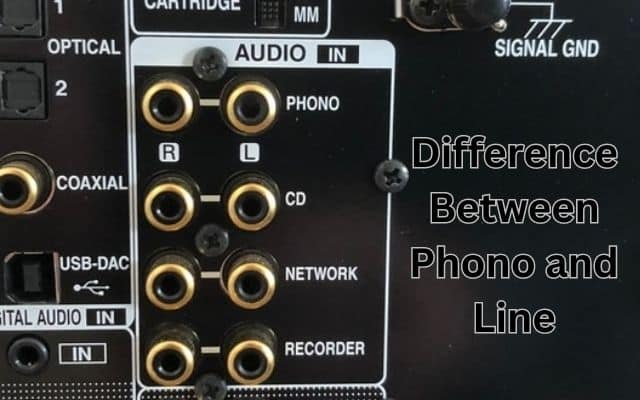What’s the Difference Between Phono and Line?

The difference Between Phono and Line signals is a common source of confusion for both new and experienced vinyl enthusiasts. Here are the differences between these two types of signals. We will explore their signal levels, frequency responses, and the role of phono preamps in converting phono signals to line signals.
Difference Between Phono and Line
Phono Signal:
A phono signal originates directly from the turntable cartridge. It is a weak signal, typically measuring around 0.005 volts. The low voltage output is due to the nature of vinyl records and the mechanics of the turntable’s stylus and cartridge. Additionally, the phono signal undergoes RIAA equalization during the vinyl mastering process to compensate for the format’s limitations, resulting in a bass reduction.
Line Signal:
In contrast, a line signal is a standardized, higher-level signal used by most audio equipment. It typically has a strength of around 0.3 volts, significantly stronger than a phono signal. Line signals originate from sources such as CD players, tape decks, or streaming devices. Unlike phono signals, line signals do not undergo RIAA equalization and do not have the same bass reduction. They are already amplified to an appropriate level for connection to amplifiers, receivers, or other audio equipment.
The Role of Phono Preamps:
A phono preamp is required to boost and equalize the weak phono signal coming from a turntable. The phono signal is amplified to line level and the necessary RIAA equalization curve is applied by a phono preamp, sometimes referred to as a phono stage or phono amplifier, in order to recreate the original frequency response. Turntables, amplifiers, and receivers can all have phono preamps, or they can be used independently. Connecting a turntable’s phono signal to a line-level input without a phono preamp would result in an extremely low volume and inaccurate sound reproduction.
Understanding Inputs:
It is essential to use the correct input when connecting audio sources to ensure proper playback and avoid potential equipment damage. Phono inputs on amplifiers, receivers, or preamps are specifically designed to handle low-level phono signals. These inputs either have built-in phono preamps or expect an external phono preamp to amplify and equalize the signal correctly. Line inputs, on the other hand, are intended for higher-level signals from sources like CD players or tape decks and do not require additional amplification.
FAQ
Q: What is the difference between a phono signal and a line signal?
A: A-line signal is an amplified version of a phono signal, which is a weak signal that originates from a turntable cartridge. In contrast to phono signals, which vary in strength depending on the type of cartridge being used, line signals are used by the majority of audio sources including CD players and streaming devices, and have a standardized signal level.
Q: Why is a phono signal weaker than a line signal?
A: Phono signals are weaker due to the nature of vinyl records and the mechanics of turntable cartridges. The low voltage output of a phono signal is a result of the physical grooves on a record and the limitations of the stylus and cartridge. On the other hand, line signals are already amplified to an appropriate level for connection to audio equipment.
Q: What is RIAA equalization?
A: RIAA equalization is a process applied to phono signals during the vinyl mastering process. It involves reducing the bass frequencies and boosting the treble frequencies to compensate for the physical limitations of vinyl records. Phono preamps or phono stages include RIAA equalization to restore the original frequency response when converting a phono signal to a line signal.
Q: What is a phono preamp?
A phono preamp, sometimes referred to as a phono stage or phono amplifier, is a component that amplifies the turntable’s weak phono signal and performs the essential RIAA equalisation. It boosts the signal to line level and ensures accurate sound reproduction. Phono preamps can be integrated into turntables, amplifiers, and receivers, or exist as standalone devices.
Q: Can I connect a turntable directly to a line input without a phono preamp?
A: No, connecting a turntable’s phono signal directly to a line input without a phono preamp will result in very low volume and incorrect sound reproduction. The phono signal needs to be amplified and equalized to match the line level and frequency response. You will either need to utilise an external phono preamp or choose a turntable with a built-in preamp or a receiver with a phono input if your turntable does not already have one.
Q: How can I tell if my turntable has a phono preamp built in?
A: To switch between phono and line output, turntables with phono preamps built in frequently contain a switch or button at the back or bottom of the device. Your turntable has a built-in phono preamp if it has this feature. Additionally, the product specifications or manual of your turntable will provide information on whether it includes a built-in preamp.
- How to Fix Common Sound Issues: A Guide for Gamers
- How to Fix sound or audio problems in Windows
- How to Fix Sound Glitches in Scorn
Conclusion:
Distinguishing between phono and line signals is crucial for setting up an audio system correctly and achieving optimal sound quality. Phono signals are weak and require amplification and equalization through a phono preamp, while line signals are already amplified and suitable for direct connection to audio equipment. By using the appropriate input and the necessary preamp, you can fully enjoy the fidelity of your vinyl records or other audio sources, creating an immersive and satisfying listening experience.







